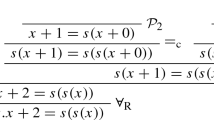Abstract
In this paper, we address the problem of enriching an interactive theorem prover with complex proof procedures. We show that the approach of building complex proof procedures out of deciders for (decidable) quantifier-free theories has many advantages: (i) deciders for quantifier-free theories provide powerful, high level functionalities which greatly simplify the activity of designing and implementing complex and higher level proof procedures; (ii) this approach is of wide applicability since most of the proof procedures are composed by steps of propositional reasoning intermixed with steps carrying out higher level strategical functionalities; (iii) decidability and efficiency are retained on important (decidable) subclasses, while they are often sacrificed by uniform proof strategies for the sake of generality; and finally (iv), from a software engineering perspective, the modularity of the procedures guarantees that any modification in the implementation can be accomplished locally. As a case study, we present and discuss a proof procedure for the existential fragment of first-order logic (prenex existential formulas without function symbols) built on top of a propositional decider.
Similar content being viewed by others
References
A. Armando and E. Giunchiglia, Embedding complex decision procedures inside an interactive theorem prover, Ann. Math. and AI 8(1993)475–502.
M. Abadi and Z. Manna, Nonclausal deduction in first-order temporal logic, J. ACM 37(1990)279–317.
P.B. Andrews, Theorem proving via general matings, J. ACM 28(1981)193–214.
M. Buro and H.K. Büning, Report on a SAT competition, Technical Report No. 110, FB-17, Mathematik/Informatik Universität Paderborn (1992).
W. Bibel,Automated Theorem Proving (Vieweg, Braunschweig, 1982).
R.S. Boyer and J.S. More, Integrating decision procedures into heuristic theorem provers: A case study of linear arithmetic, Machine Intelligence 11(1988)83–124.
B. Dreben and W.D. Goldfarb,The Decision Problem — Solvable Classes of Quantificational Formulas (Addison-Wesley, 1979).
M. Davis, G. Longemann and D. Loveland, A machine program for theorem proving, J. ACM 5(7) (1962).
M. Davis and H. Putnam, A computing procedure for quantification theory, J. ACM 7(1960)201–215.
P.C. Gilmore, A proof method for quantification theory: Its justification and realization, IBM J. Res. Develop. 4(1960)28–35.
F. Giunchiglia, The GETFOL Manual — GETFOL Version 1, Technical Report 9204-01, DIST, University of Genova, Genoa, Italy (1992). Forthcoming IRST Technical Report.
F. Harche, J.N. Hooker and G.L. Thompson, A computational study of satisfiability algorithms for propositional logic, Working Paper 1991-27 (1991).
R.G. Jeroslow, Computation-oriented reduction of predicate to propositional logic, Decision Support Syst. 4(1988)183–197.
W.H. Joyner, Resolution strategies as decision procedures, J. ACM 23(1976)398–417.
S.J. Lee and D.A. Plaisted, Eliminating duplication with the hyper-linking strategy, Technical Report TR90-032, Department of Computer Science, University of North Carolina (1990).
N.V. Murray and E. Rosenthal, Dissolution: Making paths vanish, J. ACM, to appear.
G. Nelson and D.C. Oppen, Simplification by cooperating decision procedures, Technical Report STAN-CS-78-652, Stanford Computer Science Department (1978).
F.J. Pelletier, Seventy-five problems for testing automatic theorem provers, J. Autom. Reasoning 2(1986)191–216. See also Errata Corrige in J. Autom. Reasoning 4(1988)235–236.
D. Prawitz, An improved proof procedure, Theoria 26(1960)102–139.
D. Prawitz,Natural Deduction — A Proof Theoretical Study (Almquist-Wiksell, Stockholm, 1965).
R. Reiter, Deductive questions-answering on relational databases, in:Logic and Data Bases, eds. H. Gallaire and J. Minker (Plenum Press, New York, 1978).
A. Robinson, A machine oriented logic based on the resolution principle, J. ACM 12(1965)23–41.
M. Stickel, Automated deduction by theory resolution, J. Autom. Reasoning 4(1985)333–356.
G. Winskel,The Formal Semantics of Programming Languages (MIT Press, 1993).
Author information
Authors and Affiliations
Rights and permissions
About this article
Cite this article
Giunchiglia, E., Armando, A. & Pecchiari, P. Structured proof procedures. Ann Math Artif Intell 15, 1–18 (1995). https://doi.org/10.1007/BF01535839
Issue Date:
DOI: https://doi.org/10.1007/BF01535839




